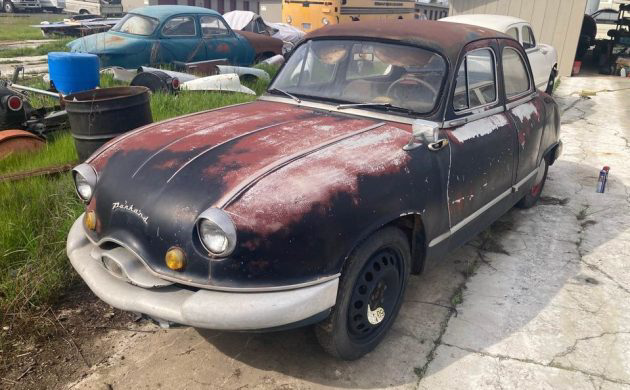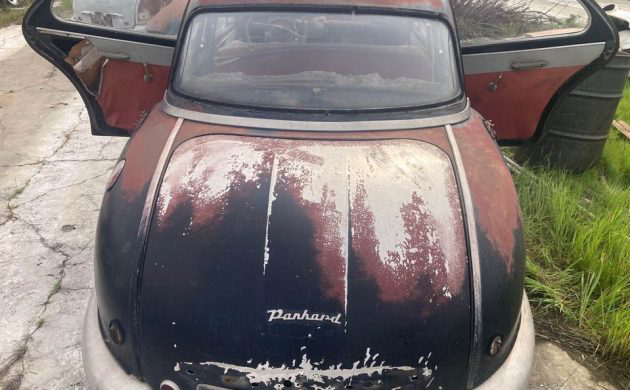
Today we’re bringing you another oddball, this one from France and doesn’t that just figure. Anyway, here on facebook Marketplace is a 1956 Panhard Dyna Z1 project, with an asking price of $1500; take a trailer to Elverta, California to pick her up. Though her best days are in the rearview mirror, this Dyna Z runs – mostly. It’s also remarkably complete, though I spy a couple of hard-to-find items that are broken. Thanks again to T.J., master of the odd, for sending this tip to us.

Panhard et Levassor was founded in 1891 as one of the world’s first automobile makers. While other makers were producing what amounted to one-offs, Panhard made multiple copies of several cars – what today we call “production runs”. It invented the front-engine, rear-drive layout, just one of its many “firsts”. Its first engines were licensed to it by Daimler. By the time the Dyna Z rolled off the line, it contained an 851 cc two-cylinder boxer motor, making about 42 hp. A four-speed manual transmission brought the power to the pavement. Cars made before 1959 were all aluminum, so performance, while slow, wasn’t nearly as bad as post-1959 when the cost of aluminum forced the company to switch to steel. The undercarriage of this example is fairly clean.

The Dyna is saturated with character inside and out. The very low coefficient of drag (0.26) and “which end is coming at me” looks, the aluminum bumpers and trim, and this funky plastic nacelle around the steering wheel bristling with switches – the Dyna screams “I’m French!” A few of these switches appear compromised, the plastic is cracked and warped here and there. That half-round portion above the steering wheel is the gauge face – clouded with age like the horn badge. Atop the gauge is what appears to be a handmade or aftermarket item – purpose unknown. If this car is destined for restoration, the new owner will face a number of challenges, as trim, switches, and engine parts for these cars are scarce. Fortunately, the trunk contains the hubcaps – so those can be crossed off the list.

The doors open very slightly upward to ease ingress. These are the rear doors; the fronts are rear-hinged. The trim, bumpers, and glass are all intact. The top photo shows the side marker lamp lens is broken – very hard to find! We bought the last Dyna Z found in these pages over a year ago, and I still haven’t found that lens. But the car is fun and weird, worth its various agonies. The best use for this example might be as a parts car; what do you think?


I love it! Problem as Michelle stated is where are you going to find needed parts? I know how hard it is to find parts for my Citroen. Ultimately I would love to find one that’s a decent driver to enjoy taking it out from time to time. That and a Ami6 to round out my weird car collection.
That’s one of mine fellas, surrounded by 10 others, all between 1956-1962, same basic layout and in same facility. The Dyna series – I call them the jellybeans smoothly rounded front & rear, started in ’54 with a totally aluminum body in white as the auto mfrs call them, weighed 220 lbs, unibody shell and all hangon panels. Then the co. realized that ally was costing them triple what they thought it would be, and probably in the first yr of production, they switched the shell to steel while keeping the hangon panels ally. The one piece clamshell hood is a treat to lift with one finger! This metal mix continued for several yrs and it’s unclear when the hangons became steel, but around ’59 is my best guess.
For having been designed in ’47 postwar, the flat twin engine is a marvel – flat twin aircooled hemi, 850 ccs pumping out a min of 40-42 hp, one piece external fin set with integrated head – no separate head – with an iron liner slipped in by heating the ally fins and dropping it in. Further, in ’54 the engine got roller lifters, tubular ally pushrods, and hydraulically adjusted valves, but not in the lifters like everyone else. Cleverly, to get to 7000 rpm in ’47 Panhard engnrs minimized reciprocating mass by floating the rocker arms on a hemispherically rounded stud pressurized by an oil line to the head. Best of all, the crank is a total rollerbearing one – mains & rods – with the rods originally using a unique dual diameter set of rollers. Why? Because the French stole one of Leonardo’s ideas from 1480, where he invented a rollerbearing with two DIFFERENT diameter rollers! Why again?
‘Cause Leonardo intuitively realized that if he put smaller diameter rollers between two loadbearing ones, the smaller one could separate the larger ones by counter-rolling against each large one to virtually eliminate sliding friction. All ball bearings have the balls spaced apart by steel cages riveted together, and the balls experience sliding friction with the cages.
Leonardo realized all he had to do to keep the smaller rollers from squirting out from between the larger loadbearing ones was put a minimal cage of aluminum over all the rollers with just slots in them for large & smaller rollers in place, while the majority of rolling friction was eliminated by only rolling contact between big & smaller rollers themselves – back in 1480!!
And to cap off all this genius in one engine, the engrs found coil valvesprings cracked to pcs at 7000 rpm or floated, so they used Torsionbar valve springs – one solid nested inside a tubular one – splined together at one end – so when one valve is pushed open, the other valve is pulled tighter shut – almost desmodromic valve operation – in this tiny two-banger.
This engine moves these 14 ft long rides up to 90 mph – half a VW motor, but same power plus higher rpm AND FWD – lots of fun! Come see –
Thanks for that really informative heads-up about the Panhard about which most of us never knew anything about. Very special engine helped by LD’Vinci. I tried to buy one about 12 years ago but the seller wouldn’t let me trailer it away as he said he would get it fired up then phone me to come and collect. About 6 weeks later I asked him if it was running yet and he told me he had sold it! He tried to explain why but I just put the phone down on him and called it a day although I was very dissapointed. Some you win, some you lose.
You know, nothing like a 1956 Panhard to take ones mind off that dismal Petty Barracuda post. Just looking at it, much less being seen in one, sure makes you think, what were they thinking? “An oddball from France”, oooh, I don’t know, the French are unpredictable, one minute they are praising you, next they are chopping off your head. And some say Kenosha turned out some odd cars.
subnote: I see I’m not the only one with long posts,,,
Yea the French have made some strange advanced car through the years.
Is this what you’re looking for? https://www.leboncoin.fr/ad/equipement_auto/2630111069
That is exactly what I want but the site does not give me an option to enter a US phone number, without which I cannot create an account. Dang!
Another useful source of things…
https://www.lesanciennes.com/
Michelle, get in touch with me. I’m in France and I can probably help. I’m am Laurent Herjean-Brichard on Facebook.
Recalling (fondly) my 1961 Panhard Tigre that I bought for $10.00 in a Florida junk yard. The car with only 10,000 miles was somehow left for junk because of a bad transmission….luckily I belonged to the Citroen Car Club (my other car was a 2 CV) where I found a tranny for $50.00. Great little car, fast and reliable!
We LOVE this crazy French stuff! Everything about it is from another planet.
The price is right!
Yet definitely a restoration snipe hunt for rare parts for sure. Recently, we MADE hydraulic cups and 3D engineered junction blocks for the rare French Momocoup central Oiling system for a Talbot, Found Eyquem wiper motors for a Villager, Fabricated rocker mounted Scissors jacks for a Delahaye, fabricated a Quillery horn button with “French Coat of arms”. restored a three-brush Paris Rone Generator for a 302 Peugeot. Yes, this stuff IS rare ! Yet, it can be done! Persistence and dedication wins. All this, our daily smorgasbord. We love this stuff! What an exciting find.
I didn’t know about the one-piece top end; I always assumed that they were on a spigot like 2CVs. I knew about the valve springs, tho’.
Buy it! As ever, it’s a good excuse to go to Retromobile…
Michelle, looks as if Ken might be your go to guy for your Dyna sidelight. Looking at the pics, I see a Panhard to the left, one in front, one in back and a Citroen DS. Surely he has a barn full of parts.
Tasty Classics on YouTube is working on one in the UK, and it is a very interesting designs in it’s style and technology. He shows how these are built.
Some of the dashboard plastic and switches might be reproduced by 3D printing.
Great idea Paolo….thanx
We reproduce plastic components every day–without 3D, using old fashioned silicon molding “dental” techniques. Unfortunately, 3D has not yet made the “Surface Quality” that reproduces the smooth cast look of the originals! As well, Thermo-plastics continue to shrink over time. So, post operations and shorter life will be the bane of the 3D world. However, 3d Metal offers a new world of innovation. We recently made NEW (originally Zinc Die Cast) door handles for a Lamborghini 350 from STAINLESS STEEL. We still had to sand off the 3D “mud dabber” texture yet buffed to a brilliance nearly like chrome. Stainless steel ! Hard to compete with this from dimensional scanning technology. New innovation makes restoration a far less expensive and obtainable process. Making nearly anything- and better- is the promise of the future.
great ideas Jim, thanx !
The only car with a cleft palet ! Absolute steal to the right byer! If it were in Australia I’d be loading now!
http://www.club-panhard-france.net/